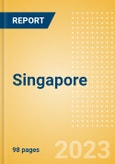The profit sector in Singapore amassed SGD15.1 billion ($11.3 billion) in 2024, yielding a CAGR of 1.6% from 2019-24. Transactions yielded a CAGR of 0.1%, while the outlet count recorded a CAGR of 0.5%.
QSR was the largest food service profit sector channel in 2024, with a share of 39.4%. It was followed by FSR with a share of 23.1%.
The foodservice profit sector is expected to reach SGD18.4 billion ($13.9 billion) in 2029, registering a CAGR of 4% during 2024-29. The number of transactions will register a CAGR of 2%, while the number of outlets will generate a CAGR of 0.6% over the period. Tourism will continue to contribute to the profit sector’s value growth.
Scope
Macro context:
- Understanding the wider economic and social trends within a country; key to providing background when looking into a specific industry.
Profit sector channels:
- A number of foodservice channels have been grouped together to form the “profit sector”; these include accommodation, leisure, restaurants, retail, travel, workplace, and pub, club & bar. This section will first go through overall trends in the sector, then “deep dive” into each of the four key channels. These channels are QSR, FSR, coffee & tea shop, and pub, club & bar. The report structure for each of these channels is explained below.
Cost sector channels:
- A number of foodservice channels have been grouped together to form the “cost sector”; these include education, healthcare, military & civil defense, and welfare & services. This sector typically represents the state’s foodservice operators. This section of the report will go through overall trends in the sector. Profit sector sub-sections - QSR, FSR, coffee & tea shop, and pub, club & bar:
Cost sector:
- For the overall cost sector channel, this report will provide an overview of the performance of the channel. The report section will cover historic and forecast growth/decline and will finish with a look into the data and channel share breakdown.
Reasons to Buy
- Specific forecasts of the foodservice market over the next five years (2024-29) will give readers the ability to make informed business decisions through identifying emerging/declining markets.
- Consumer segmentation detailing the desires of known consumers among all major foodservice channels (QSR, FSR, and coffee & tea shop) will allow readers understand the wants and needs of their target demographics.
Table of Contents
- Introduction
- Report Guide
- Executive Summary
- Macroeconomic Context
- Macroeconomic Overview
- Trends Landscape
- Profit Sector - Consumer Behavior
- Profit Sector Metrics
- Key Metric Highlights
- Value Share and Growth by Channel
- Outlets and Transactions Growth by Channel
- Operator Buying Volumes and Growth by Channel
- Channel Historic and Future Growth Dynamics
- Outlet-Type and Owner-Type Growth Dynamics
- Profit Sector by Channel
- Quick-Service Restaurant (QSR)
- Enablers and Inhibitors of Growth
- Metrics
- Key Players
- Who?
- Why?
- What?
- Where?
- What Next?
- Full-Service Restaurant (FSR)
- Enablers and Inhibitors of Growth
- Metrics
- Key Players
- Who?
- Why?
- What?
- Where?
- What Next?
- Coffee & Tea Shop
- Enablers and Inhibitors of Growth
- Metrics
- Key Players
- Who?
- Why?
- What?
- Where?
- What Next?
- Pub, Club & Bar
- Enablers and Inhibitors of Growth
- Metrics
- Key Players
- Who?
- Why?
- What?
- Where?
- What Next?
- Cost Sector Metrics
- Cost Operator Trends - Historic and Future Growth
- Data and Channel Share Breakdown
- Appendix
Companies Mentioned (Partial List)
A selection of companies mentioned in this report includes, but is not limited to:
- McDonald’s
- Restaurant Brands International
- Roark Capital
- Chang Cheng
- Yum! Brands
- Taster Food
- Imperial Treasure Restaurants
- TungLok
- Y.E.S. F&B
- Starbucks
- BreadTalk
- International Coffee & Tea
- Royal T
- KOI Thé
- Harry's International
- Georges
- BLVD








